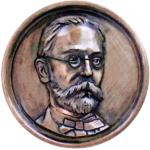W opracowaniu
Aktualny numer
Numery specjalne
Archiwum
O czasopiśmie
Redakcja
Rada Redakcyjna
Recenzenci
Instrukcja redakcyjna
Zasady etyki publikacyjnej
Zasady recenzowania
Ghostwriting
Prawa autorskie i polityka Open Access
Klauzula informacyjna RODO – dla autorów artykułów zgłoszonych do publikacji w kwartalniku „Komunikaty Mazursko-Warmińskie”
Kontakt
Cennik
PROJEKTY
Kościół wobec idei krucjatowych
podczas chrystianizacji Prusów
1
Instytut Historii i Stosunków Międzynarodowych
Uniwersytet Warmińsko-Mazurski w Olsztynie
Data publikacji online: 23-11-2016
Data publikacji: 23-11-2016
KMW 2016;293(3):417-429
SŁOWA KLUCZOWE
DZIEDZINY
STRESZCZENIE
A theological-philosophical patron of crusades was St. Augustine of Hippo (354-430), one of the Fathers of Church, who in his The City of God (De Civitate Dei) assumed that the human mankind could be divided into two categories – the one constituting the civitas Dei, acting in the name of God, and civitas terrena,
including disbelievers and Muslims. According to St. Augustine, the coming of Christ would put an end to the history of humanity – at that time believers would be rewarded with eternal happiness whereas disbelievers
would be damned. Only when fighting in the name of God, in the defence of the Church, the knights could be
useful for the society. This attitude was represented by Pope Gregory VII (1020-1085).
A great propagator of the Augustinian doctrine was St. Bernard of Clairvaux (1090–1153) who reformed it for the sake of crusades. In his famous In Praise of the New Knighthood (De laude novae militae) he established the rule of the order of the Knights Templar. A motif of the martyr’s death could become a sufficient
reason to undertake further actions of Christianisation, having the at the same time eschatological and practical dimension. In the context of an overall crusade movement, the martyrdom of St. Adalbert or Five Martyr
Brothers as well as St. Bruno, seems to serve as a symbol and pretext for crusades being rather penitence pilgrimages of reconciliation with redemptory valor. There was nothing more convincing to undertake a military action than a penitential mission ensuring eternal salvation. It is presumed that even in the first period the
missionary action might have been conducted by the Płock bishop Alexander of Malonne (1129-1156).
On 3 March 1217 Pope Honorius III (1150–1227), presumably on the initiative of the then papal legate in Prussia, the Gniezno archbishop Henryk Kietlicz and bishop Chrystian (1180-1245), allowed the knights
of Mazovia and Lesser Poland to organize an expedition to Prussia in return for participation in the Palestinian crusade. As the results of converting pagans by means of sword by Polish or Scandinavian expeditions
were rather scarce, the orders were entrusted with a defence and development of the mission of Christianisation. They adopted a strategy to shatter the community of tribes – in Prussia by means of attracting the nobility, in Livonia by formenting discord among tribes.
Przetwarzamy dane osobowe zbierane podczas odwiedzania serwisu. Realizacja funkcji pozyskiwania informacji o użytkownikach i ich zachowaniu odbywa się poprzez dobrowolnie wprowadzone w formularzach informacje oraz zapisywanie w urządzeniach końcowych plików cookies (tzw. ciasteczka). Dane, w tym pliki cookies, wykorzystywane są w celu realizacji usług, zapewnienia wygodnego korzystania ze strony oraz w celu monitorowania ruchu zgodnie z Polityką prywatności. Dane są także zbierane i przetwarzane przez narzędzie Google Analytics (więcej).
Możesz zmienić ustawienia cookies w swojej przeglądarce. Ograniczenie stosowania plików cookies w konfiguracji przeglądarki może wpłynąć na niektóre funkcjonalności dostępne na stronie.
Możesz zmienić ustawienia cookies w swojej przeglądarce. Ograniczenie stosowania plików cookies w konfiguracji przeglądarki może wpłynąć na niektóre funkcjonalności dostępne na stronie.




